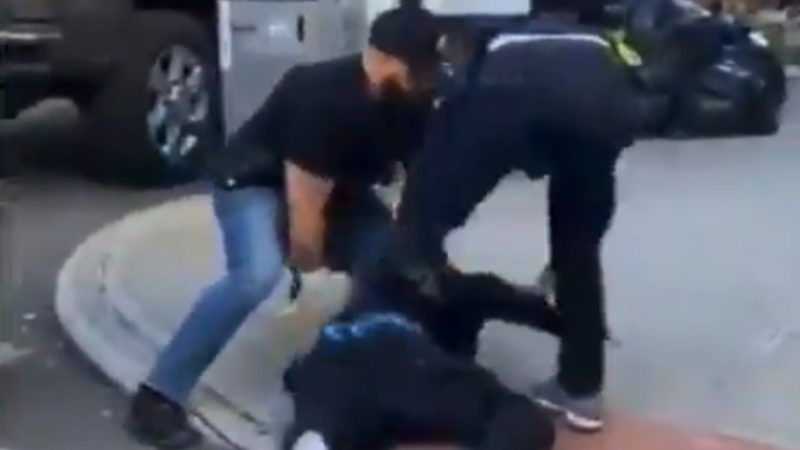The NYPD's Violent COVID-19 Arrests Show It Hasn't Learned Much in the 6 Years Since Eric Garner's Death
To the NYPD, everything still looks like a nail.

In the course of a single week, the New York Police Department (NYPD) has conducted at least three violent arrests for violating social-distancing orders. As the sixth anniversary of Eric Garner's death approaches, these arrests suggest that the department hasn't learned any lessons.
The July 2014 video of Daniel Pantaleo and other NYPD officers using lethal force on an unarmed Garner is deeply embedded in the American consciousness. Garner became a national face of the issue of police violence—and, unlike other prominent police killings around the time, it was captured completely on video, making it harder for people to justify. Conservatives who were hesitant to support the Ferguson protests spoke out against the death, and against the decision not to indict Pantaleo. Most rational people could agree that a suspected offense as trivial as selling single, untaxed cigarettes did not merit violence.
The NYPD, on the other hand, still seems intent on violently cracking down on nonviolent crimes. In a single week, at least three violent arrests for social-distancing violations have gone viral:
CW: Police violence
This evening in Manhattan, an NYPD officer approaches a group of people filming an arrest, deploys his taser indiscriminately, then grabs a young man and, without provocation, slams him to the ground, starts beating him and, with another cop, handcuffs him. pic.twitter.com/N6bENczkOU
— Rebecca Kavanagh (@DrRJKavanagh) May 3, 2020
Bias policing by the @NYPDnews @NYPD75Pct of Black Youth regarding #SocialDistancing. This does not happen to white people who violate social distancing. They are using the #pandemic as a weapon for further brutality. @NYCMayor @NYPDShea bring your rabid animals to heel! pic.twitter.com/d2maQYhokg
— Dr. Anthony Beckford (@AnthonyBNYC) May 5, 2020
More state sanctioned racial terrorism in #Brooklyn #NY
The #AntiBlackWar is NEVER going to stop until BLACK PEOPLE make them stop.Black ppl in #NYC please please please understand that you are in a white supremacist battle zone.#FearisNotAnOption#KoupeTetBouleKay pic.twitter.com/9F1gWzVgcC
— Tariq Nasheed ???????? (@tariqnasheed) May 6, 2020
Perhaps the worst part about these videos is the fact that the NYPD simultaneously spent the entire weekend tweeting pictures of other officers simply handing out masks to unmasked people on the street.
The protests, the bad press, the legal action, and all the other aftershocks from Garner's death should have forced the NYPD to reevaluate its priorities and tactics. And Garner's death did inspire some changes, including a use-of-force database, efforts to implement neighborhood policing, body cameras, and the reduction of stop-and-frisk.
But the NYPD's culture still largely accepts violent arrests of nonviolent offenders.
When a lieutenant first heard that Garner was most likely dead, he texted, "Not a big deal. We were effecting a lawful arrest." While advocates were calling for more accountability and better policing tactics, police were using anonymous forums to blame Garner for his own death. When Pantaleo was finally fired last year, the police union encouraged officers to retaliate by conducting fewer arrests. Citations dropped and petty crime enforcement appeared to halt. (This tactic backfired: Crime levels dropped too.)
While reacting to a policeman punching a suspect during a social-distancing arrest, NYPD Commissioner Dermot Shea claimed that such a punch "should not be assumed to be excessive force," since it is an escalation tactic used in police academy training. Many departments refocused their policing on violent offenses to avoid clogging jails with nonviolent offenders during the pandemic, but Shea said the NYPD would adopt no such change.
The incidents this week could have been avoided if more people had taken the time to ask whether nonviolent offenses are really worth a beatdown.


Show Comments (41)